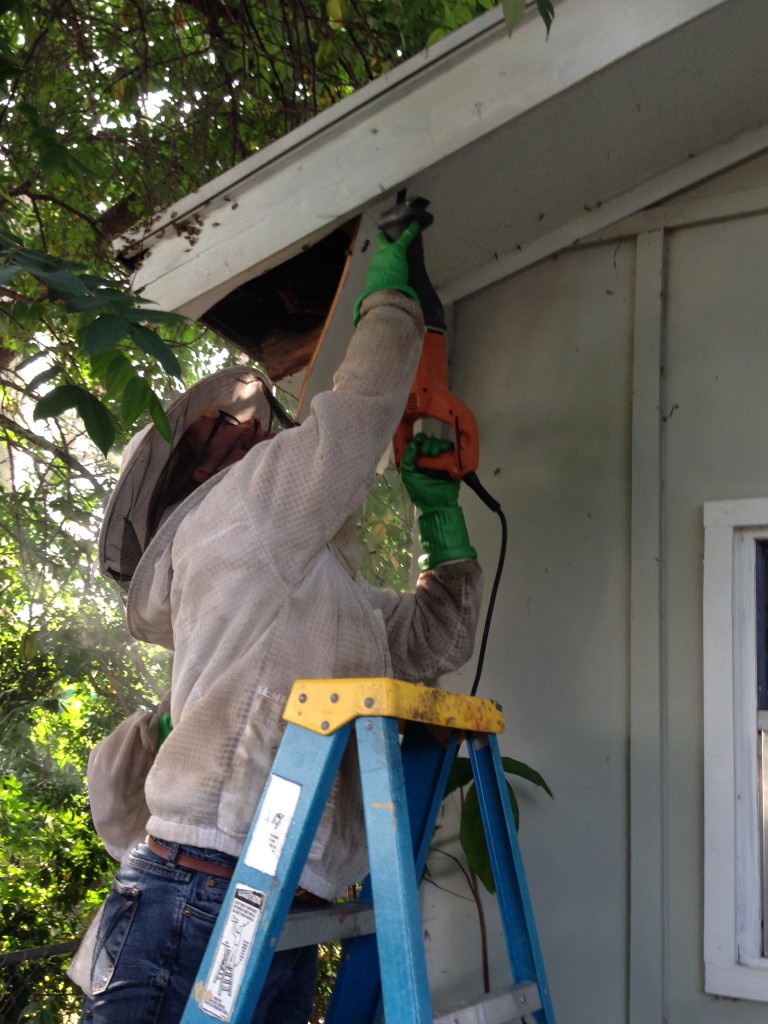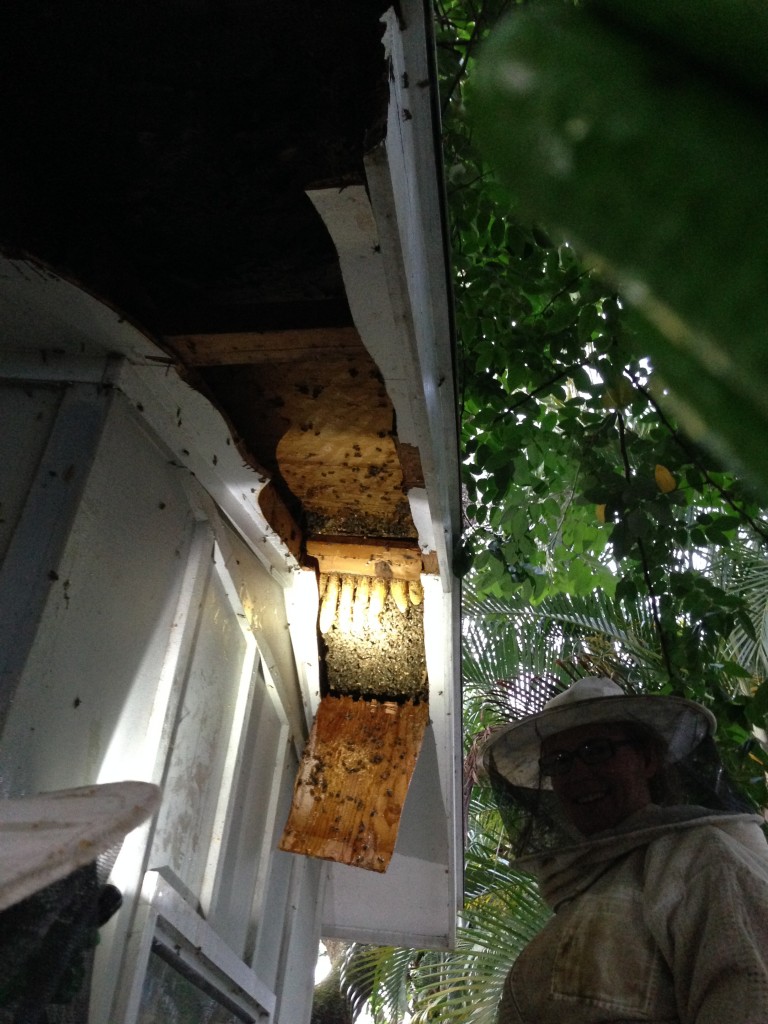Working with bees is exhilarating and empowering. There is a lot of deep breathing involved, especially if you are stung, because bees will react to your fear.
A couple days after I arrived in Florida, Sierra got called out on a live bee removal for some friends of friends. The family was reluctant to see the bees go, but they were ready to renovate a small wooden shed in the back yard and the bees who lived in the soffit (eaves) were very much in the way (read: nobody dared approach that general area). As it turned out, the hive was REALLY BIG.
The three of us arrived late afternoon – it’s sweltering in those bee suits – and assessed the situation and set up the area. Basically, every beekeeper needs a bee jacket, a hive tool, and a smoker. For the removal, we also had a swarm box inside a larger vacuum box with a hose attached, large plastic trash bags, clean 5-gal buckets for honey, ladder, saws, and various other potential useful tools.
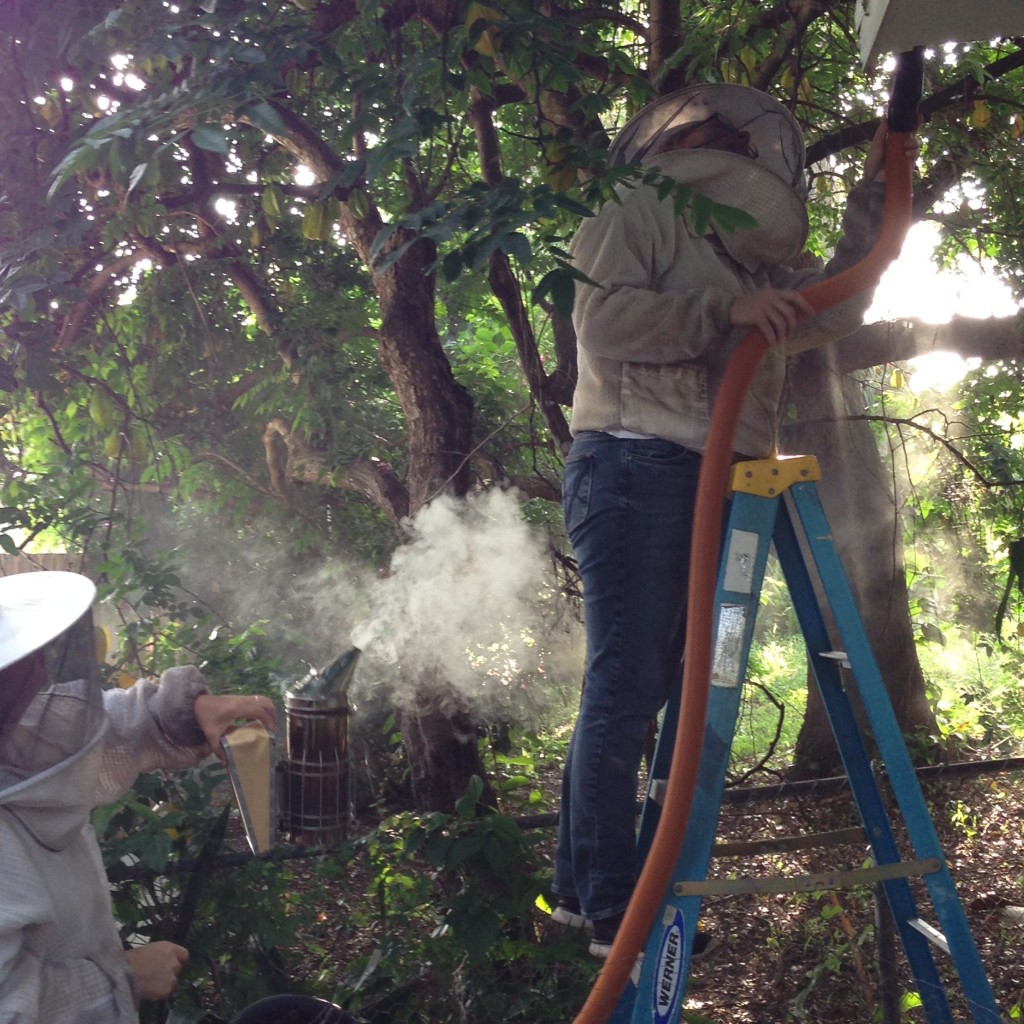
Sierra used as little smok as possible but Nicole and I wanted to use it heavily to sedate and disorient the bees. Once a lady bee stung you and released an “attack” pheromone, her sisters would angrily congregate to sting the same spot.
The main object is to find the queen, because she is the vibrant egg-laying fertile heart of any bee colony. The queen is essential to a healthy colony, but  there are several circumstances when a hive is (momentarily) queen-less. When this is the case, the bees are typically cranky (no leadership!) and even make a different sound than a queened hive. Once the queen is captured (there are special queen cages for this purpose) the hive will follow. The problem is that the queen, essential as she is, usually lives deep in the layers of comb, attended by a worker bee retinue. This hive proved to be queen-less, a theory that was substantiated by the finding of several queen cells. The colony was awaiting a new queen to emerge and the old queen had probably taken off (“swarmed”) with approximately half the worker bees several days previously.
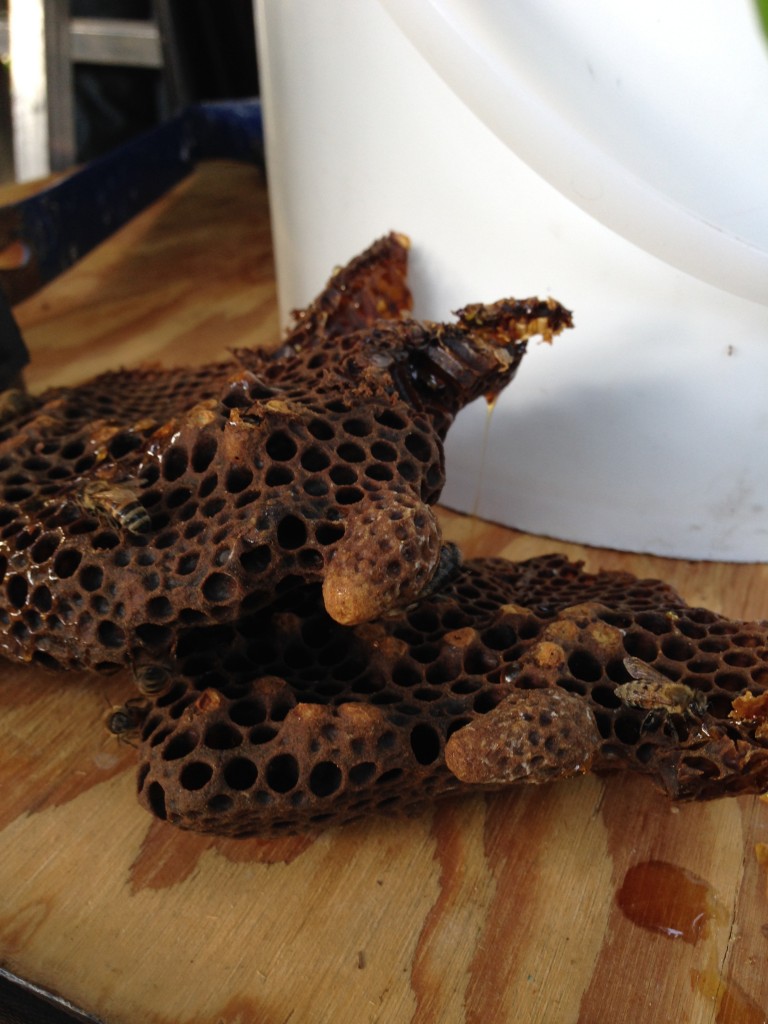
The queen cells are the size of a peanut – they are so much bigger than the worker cells that they take over and absorb dozens of worker bee-sized cells. Sierra uncapped a few queen cells so we could all get a taste of royal jelly.
My favorite bee fact is the fact that the queen and the worker bees start from the exact same eggs laid by the exact same queen. While all the larvae are initially fed royal jelly for three days, most are switched over to bee bread for the rest of their larval growth stage. Larva intended to become queens are only ever fed royal jelly and their growth is not only accelerated but queens are nearly triple in size when born. Plus queens have extra special reproductive mating and egg-laying powers.
The only difference between a queen and a worker is what she is fed as she is growing up. How’s that for a sobering lesson on the importance of childhood nutrition?
So the first thing we did was to puff smoke at the bees. It’s supposed to help, but the buzzing of the bees gets distinctly louder and angrier when smoke is involved. Then we began to vacuum as many bees as possible into a bee box that is enclosed inside a larger wooden vacuum box. The idea is to get as many bees as possible plus the queen and take them away – alive – to start a new home elsewhere. The problem is that the old bee home, the hive, smells like bees and honey and will attract other bees who might move in, so the other goal is to scrape every single bit of comb off and to take it with us.
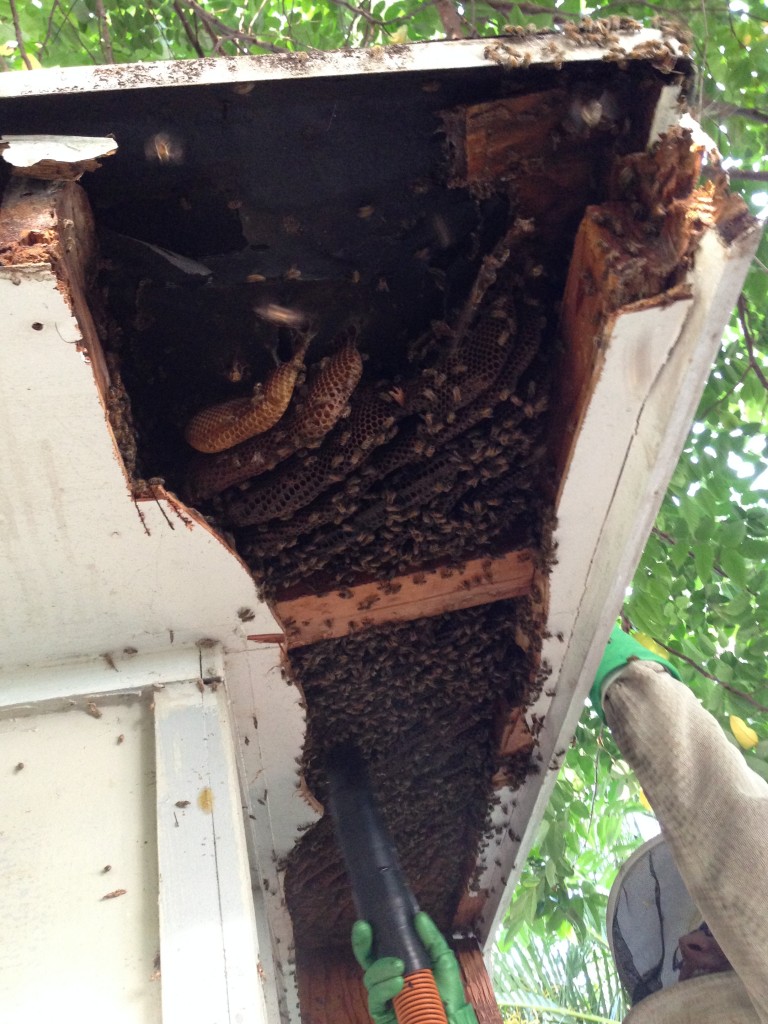
The hive just kept going and going. Perhaps you can tell from the wavy cut lines that this was Sierra’s first time using power tools for a “cut-out”
Taking off the comb is a tricky business. The comb is tenaciously plastered to the wood with propolis, which is code for bee cement. Basically, it was like scraping dried glue up above my head while on a ladder, with swarms of angry bees buzzing, with very sticky heavy honey raining down on me; all done with limited vision because of the mesh veil and rivulets of sweat running into my eyes. I only managed to do it for 30 seconds. It was scary, hard work! Note in these pics that Sierra and Nicole are cool as cucumbers. Pretty impressive. Bees can sting through jeans, you know.
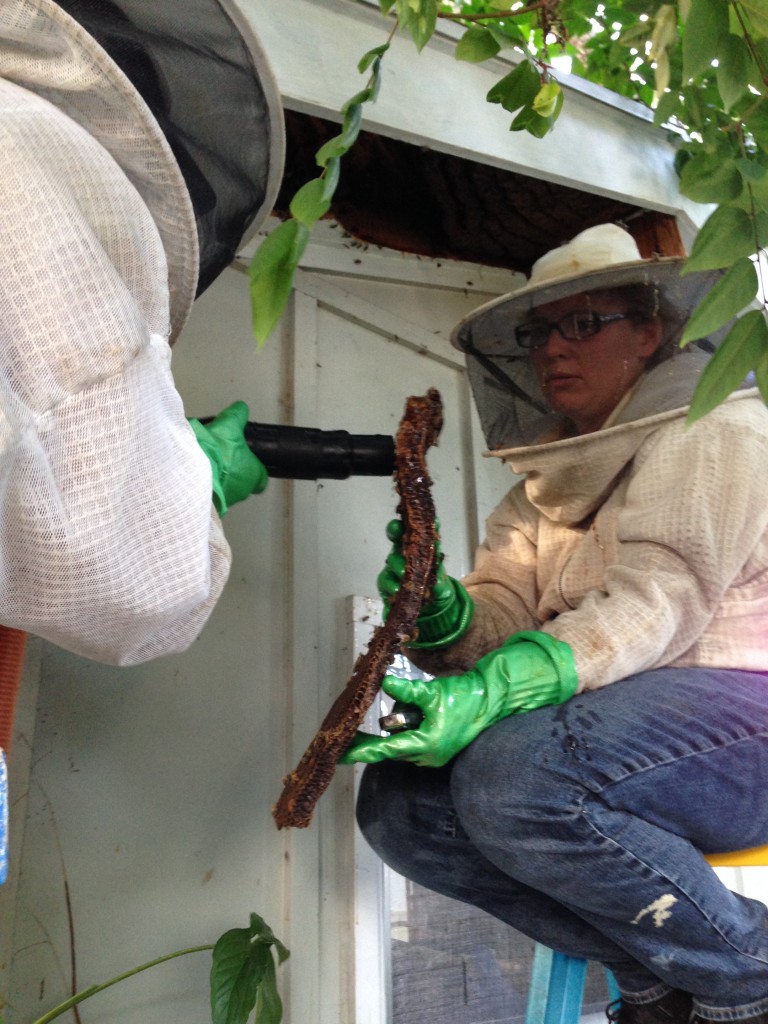
Each piece of comb was vacuumed of bees before being put into either a large black trash bag (regular comb) or a bucket lined with a paint strainer mesh (honey comb). It was literally raining honey.
Sierra would cut the wood back with an electric saw and expose the bees. One of us would begin vacuuming while another scraped the comb off in long lengths. Every length of comb was vacuumed for more bees before being sorted into the appropriate container. Cut, scrape, and vacuum; cut, scrape, and vacuum; we did this for three hours; we did this past sunset with flashlights.
The cells of bee comb are extremely versatile and are used for everything from a larva nursery to a food larder, so some comb was full of brood and others were full of capped honey. Honey comb was put into a 5-gal food grade BPA-free bucket that was lined with a paint strainer bag. Brood comb was put into a black 50-gal trash bag to be later processed for beeswax. While a live hive removal is clearly vastly ethically superior to a poisonous extermination, some bees were definitely harmed in this process. I can see why vegans don’t eat honey.
This live bee removal was one of my major highlights of my Florida trip. It was a huge adrenaline rush to be surrounded by bees and to continue breathing slowly while working on the important task of saving this beehive. At one moment a bee was crawling up inside my jeans. I nearly panicked. I was stung and it HURT. I learned to tape up the bottom of my pants after that, but one sting compared to the enormity of this hive (how many thousands of bees we relocated?), made my pain feel relatively minute.

